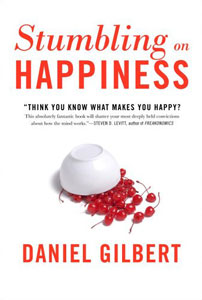Related Research Articles
Feelings are subjective self-contained phenomenal experiences. According to the APA Dictionary of Psychology, a feeling is "a self-contained phenomenal experience"; and feelings are "subjective, evaluative, and independent of the sensations, thoughts, or images evoking them". The term feeling is closely related to, but not the same as emotion. "Feeling" may for instance refer to the conscious subjective experience of emotions. The study of subjective experiences is referred to as phenomenology. The discipline of psychotherapy generally involves a therapist helping a client understand, articulate and learn to effectively regulate their own feelings and ultimately take responsibility for their experience of the world. Feelings are sometimes held to be characteristic of embodied consciousness.
Hindsight bias, also known as the knew-it-all-along phenomenon or creeping determinism, is the common tendency for people to perceive past events as having been more predictable than they actually were. People often believe that after an event has occurred, they would have predicted or perhaps even would have known with a high degree of certainty what the outcome of the event would have been before the event occurred.
In psychology, the false consensus effect, also known as consensus bias, is a pervasive cognitive bias that causes people to “see their own behavioral choices and judgments as relatively common and appropriate to existing circumstances”. In other words, they assume that their personal qualities, characteristics, beliefs, and actions are relatively widespread through the general population.
The peak–end rule is a psychological heuristic in which people judge an experience largely based on how they felt at its peak and at its end, rather than based on the total sum or average of every moment of the experience. The effect occurs regardless of whether the experience is pleasant or unpleasant. To the heuristic, other information aside from that of the peak and end of the experience is not lost, but it is not used. This includes net pleasantness or unpleasantness and how long the experience lasted. The peak–end rule is thereby a specific form of the more general extension neglect and duration neglect.

The planning fallacy is a phenomenon in which predictions about how much time will be needed to complete a future task display an optimism bias and underestimate the time needed. This phenomenon sometimes occurs regardless of the individual's knowledge that past tasks of a similar nature have taken longer to complete than generally planned. The bias affects predictions only about one's own tasks; when outside observers predict task completion times, they tend to exhibit a pessimistic bias, overestimating the time needed. The planning fallacy involves estimates of task completion times more optimistic than those encountered in similar projects in the past.

The simulation heuristic is a psychological heuristic, or simplified mental strategy, according to which people determine the likelihood of an event based on how easy it is to picture the event mentally. Partially as a result, people experience more regret over outcomes that are easier to imagine, such as "near misses". The simulation heuristic was first theorized by psychologists Daniel Kahneman and Amos Tversky as a specialized adaptation of the availability heuristic to explain counterfactual thinking and regret. However, it is not the same as the availability heuristic. Specifically the simulation heuristic is defined as "how perceivers tend to substitute normal antecedent events for exceptional ones in psychologically 'undoing' this specific outcome."
Affective forecasting is the prediction of one's affect in the future. As a process that influences preferences, decisions, and behavior, affective forecasting is studied by both psychologists and economists, with broad applications.

Affect, in psychology, refers to the underlying experience of feeling, emotion or mood.

Regret is the emotion of wishing one had made a different decision in the past, because the consequences of the decision were unfavorable.

Stumbling on Happiness is a nonfiction book by Daniel Gilbert, published in the United States and Canada in 2006 by Knopf. It has been translated into more than thirty languages and is a New York Times bestseller.
An emotional bias is a distortion in cognition and decision making due to emotional factors.
Optimism bias is a cognitive bias that causes someone to believe that they themselves are less likely to experience a negative event. It is also known as unrealistic optimism or comparative optimism.
Appraisal theory is the theory in psychology that emotions are extracted from our evaluations of events that cause specific reactions in different people. Essentially, our appraisal of a situation causes an emotional, or affective, response that is going to be based on that appraisal. An example of this is going on a first date. If the date is perceived as positive, one might feel happiness, joy, giddiness, excitement, and/or anticipation, because they have appraised this event as one that could have positive long-term effects, i.e. starting a new relationship, engagement, or even marriage. On the other hand, if the date is perceived negatively, then our emotions, as a result, might include dejection, sadness, emptiness, or fear. Reasoning and understanding of one's emotional reaction becomes important for future appraisals as well. The important aspect of the appraisal theory is that it accounts for individual variability in emotional reactions to the same event.
The negativity bias, also known as the negativity effect, is the notion that, even when of equal intensity, things of a more negative nature have a greater effect on one's psychological state and processes than neutral or positive things. In other words, something very positive will generally have less of an impact on a person's behavior and cognition than something equally emotional but negative. The negativity bias has been investigated within many different domains, including the formation of impressions and general evaluations; attention, learning, and memory; and decision-making and risk considerations.
One way of thinking holds that the mental process of decision-making is rational: a formal process based on optimizing utility. Rational thinking and decision-making does not leave much room for emotions. In fact, emotions are often considered irrational occurrences that may distort reasoning.
Distinction bias, a concept of decision theory, is the tendency to view two options as more distinctive when evaluating them simultaneously than when evaluating them separately.
Life satisfaction is a measure of a person's well-being, assessed in terms of mood, relationship satisfaction, achieved goals, self-concepts, and self-perceived ability to cope with life. Life satisfaction involves a favorable attitude towards one's life—rather than an assessment of current feelings. Life satisfaction has been measured in relation to economic standing, degree of education, experiences, residence, and other factors.

Subjective well-being (SWB) is a self-reported measure of well-being, typically obtained by questionnaire.
The fading affect bias, more commonly known as FAB, is a psychological phenomenon in which memories associated with negative emotions tend to be forgotten more quickly than those associated with positive emotions. It is important to note that FAB only refers to the feelings one has associated with the memories and not the content of the memories themselves. Early research studied FAB retrospectively, or through personal reflection, which brought about some criticism because retrospective analysis can be affected by subjective retrospective biases. However, new research using non-retrospective recall studies have found evidence for FAB., and the phenomenon has become largely accepted.
References
- ↑ Wilson, Timothy D.; Gilbert, Daniel T. (2005). "Affective Forecasting: Knowing What to Want". Current Directions in Psychological Science. 14 (3): 131–134. ISSN 0963-7214.
- 1 2 Zanna, Mark P. (2003). "Affective Forecasting". Advances in Experimental Psychology. Academic.
- 1 2 Buehler, Roger; McFarland, Cathy (2 November 2001). "Intensity Bias in Affective Forecasting: The Role of Temporal Focus". Personality and Social Psychology Bulletin. 27 (11): 1480–1493. doi:10.1177/01461672012711009.
- 1 2 3 4 5 6 7 8 9 Wilson, Timothy D.; Gilbert, Daniel T. (23 June 2016). "Affective Forecasting". Current Directions in Psychological Science. 14 (3): 131–134. doi:10.1111/j.0963-7214.2005.00355.x.
- 1 2 Gilbert, Daniel T.; Pinel, Elizabeth C.; Wilson, Timothy D.; Blumberg, Stephen J.; Wheatley, Thalia P. (1998). "Immune neglect: A source of durability bias in affective forecasting" (PDF). Journal of Personality and Social Psychology. 75 (3): 617–638. doi:10.1037/0022-3514.75.3.617. PMID 9781405. Archived from the original on 2016-05-17.
{{cite journal}}: CS1 maint: bot: original URL status unknown (link) - ↑ Sheldon, Kennon M.; Gunz, Alexander; Nichols, Charles P.; Ferguson, Yuna (February 2010). "Extrinsic Value Orientation and Affective Forecasting: Overestimating the Rewards, Underestimating the Costs". Journal of Personality. 78 (1): 149–178. doi:10.1111/j.1467-6494.2009.00612.x.
- ↑ Schkade, David A.; Kahneman, Daniel (6 May 2016). "Does Living in California Make People Happy? A Focusing Illusion in Judgments of Life Satisfaction". Psychological Science. 9 (5): 340–346. doi:10.1111/1467-9280.00066.
- ↑ Hsee, Christopher K.; Zhang, Jiao (2004). "Distinction Bias: Misprediction and Mischoice Due to Joint Evaluation". Journal of Personality and Social Psychology. 86 (5): 680–695. doi:10.1037/0022-3514.86.5.680. PMID 15161394.
- ↑ Wilson, Timothy D.; Meyers, Jay; Gilbert, Daniel T. (1 December 2003). ""How Happy Was I, Anyway?" A Retrospective Impact Bias". Social Cognition. 21 (6): 421–446. doi:10.1521/soco.21.6.421.28688. ISSN 0278-016X.
- ↑ Gautam, Shalini; Bulley, Adam; von Hippel, William; Suddendorf, Thomas (2017-07-01). "Affective forecasting bias in preschool children". Journal of Experimental Child Psychology. 159: 175–184. doi:10.1016/j.jecp.2017.02.005. ISSN 0022-0965. PMID 28288413.
- ↑ Kopp, Leia; Atance, Cristina M.; Pearce, Sean (2017-09-13). "'Things aren't so bad!': Preschoolers overpredict the emotional intensity of negative outcomes". British Journal of Developmental Psychology. 35 (4): 623–627. doi:10.1111/bjdp.12210. ISSN 0261-510X. PMID 28901558.
- Sources
- Wilson, Timothy D.; Wheatley, Thalia; Meyers, Jonathan M.; Gilbert, Daniel T.; Axsom, Danny (2000). "Focalism: A source of durability bias in affective forecasting". Journal of Personality and Social Psychology. 78 (5): 821–836. doi:10.1037/0022-3514.78.5.821. ISSN 1939-1315.
- Wilson, Timothy D.; Gilbert, Daniel T. (23 June 2016). "Affective Forecasting". Current Directions in Psychological Science. 14 (3): 131–134. doi:10.1111/j.0963-7214.2005.00355.x.